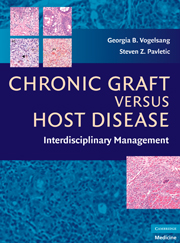Book contents
- Frontmatter
- Contents
- List of Contributors
- Preface
- PART I GENERAL PRINCIPLES
- PART II CLINICAL MANAGEMENT
- 9 Diagnosis and Staging
- 10 Chronic Graft versus Host Disease Pharmacology
- 11 Prevention of Chronic Graft versus Host Disease
- 12 Front Line Treatment of Chronic Graft versus Host Disease
- 13 Salvage Therapy in Chronic Graft versus Host Disease
- 14 Evaluating Therapeutic Response in Chronic Graft versus Host Disease
- 15 General Principles of Ancillary and Supportive Care
- PART III ORGAN SITE OR SYSTEM-SPECIFIC MANIFESTATIONS
- PART IV SPECIAL CONSIDERATIONS IN CHRONIC GVHD
- Index
- Plate section
10 - Chronic Graft versus Host Disease Pharmacology
from PART II - CLINICAL MANAGEMENT
Published online by Cambridge University Press: 26 August 2009
- Frontmatter
- Contents
- List of Contributors
- Preface
- PART I GENERAL PRINCIPLES
- PART II CLINICAL MANAGEMENT
- 9 Diagnosis and Staging
- 10 Chronic Graft versus Host Disease Pharmacology
- 11 Prevention of Chronic Graft versus Host Disease
- 12 Front Line Treatment of Chronic Graft versus Host Disease
- 13 Salvage Therapy in Chronic Graft versus Host Disease
- 14 Evaluating Therapeutic Response in Chronic Graft versus Host Disease
- 15 General Principles of Ancillary and Supportive Care
- PART III ORGAN SITE OR SYSTEM-SPECIFIC MANIFESTATIONS
- PART IV SPECIAL CONSIDERATIONS IN CHRONIC GVHD
- Index
- Plate section
Summary
This chapter focuses on the pharmacology, pharmacokinetics, drug interactions, and toxicity of commonly utilized immunosuppressive agents in the management of chronic graft versus host disease (cGVHD). The agents selected for review within this chapter include the corticosteroids, the calcineurin inhibitors, mycophenolate mofetil, thalidomide, and sirolimus. Table 10.1 summarizes additional pharmacologic agents that have been utilized for the systemic management of cGVHD.
CORTICOSTEROIDS
Corticosteroids and, most notably, prednisone are generally considered the mainstay and drug of choice for the initial treatment of cGVHD. Prednisone has utility as a single agent in the initial therapy of cGVHD, particularly in standard risk patients and in combination therapy with a calcineurin inhibitor, such as cyclosporine, for high-risk patients. The clinical application of prednisone in the treatment of cGVHD is summarized in Chapter 12.
Pharmacology
Corticosteroids impact an extensive number of physiologic functions within the body including carbohydrate, protein, and lipid metabolism; maintenance of fluid and electrolyte balance; and preservation of a variety of organ systems including the cardiovascular, immune, skeletal muscle, renal, endocrine, and nervous systems. Corticosteroids are classified according to their relative potencies in sodium retention (i.e., mineralocorticoid activity) and their effects on glucose or carbohydrate metabolism (i.e., glucocorticoid activity). The potency of a corticosteroid to impact glucose metabolism closely parallels those for anti-inflammatory activity (refer to Table 10.2).
- Type
- Chapter
- Information
- Chronic Graft Versus Host DiseaseInterdisciplinary Management, pp. 101 - 116Publisher: Cambridge University PressPrint publication year: 2009



